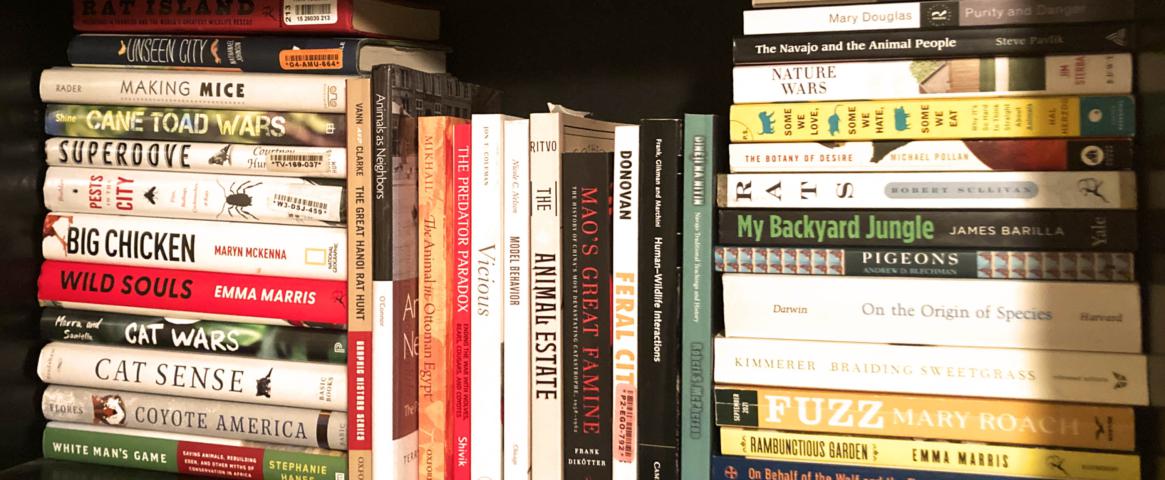
Bethany Brookshire—PESTS: How Humans Create Animal Villains
Bethany Brookshire
Ecco (HarperCollins), December 6, 2022, $28.99 US, $35.99 CAN
ISBN-10: 0063097257, ISBN-13: 978-0063097254
ASIN B09V2Z1R9Z
Brookshire reports:
The ideas for this book had been swirling since I wrote a piece in 2016 for Science News documenting the first evidence of mice associated with human settlement.
I was fascinated by the idea that we’d had house mice since we had houses, before we started farming. That finding clumped together with other findings in my head, like studies about coyotes in urban environments and whether rats were the spreaders of the Black Death. I began to see a theme, that animals we call pests are those that succeed in our environments, and we hate them because they do.
In 2019, I was accepted into the 2019-2020 class of the MIT Knight Science Journalism program. That fellowship gave me the opportunity to dive into human-wildlife interactions and find my agent. It also introduced me to a wonderful class of fellows who listened and helped me develop my ideas. By the end of the fellowship, I had a proposal ready for submission.I was able to leave my job (though I miss my Science News colleagues!) and live off my advance while I did the research and writing. If there’s one thing that I wish I’d known, it would be how much a global pandemic would affect my work. COVID-19 disrupted most of my travel plans and stunted efforts to develop some very important sources. But I was able to pivot, and I hope the result is a journey, no matter how little I physically traveled.
If I can recommend anything, it’s organization. Organize everything. I don’t care how you do it. Develop a file naming system that works for you and stick with it. It will make your life so much easier.
Photo courtesy of Bethany Brookshire
I also outlined every chapter before I started writing, using a chalkboard. The x-axis of each graph is the word count of the chapter, and the Y-axis is the rising and falling action of the section. I tried to balance small sections and larger sections, a technique that I picked up from Michael Pollan, who referred to narrative as laundry on a line, balancing larger and smaller items to keep it moving. The dotted lines are incomplete sections (obviously since completed!) and the solid lines are ones that have been drafted. The post-its are color-coded according to the topic: science, history, culture, ethics, and so on. My outline allowed me to see and keep track of what had been done, what needed to be completed or reordered, and what sources I needed and where.
Finally: Cite as you write. Put the interview timestamps and paper links in comments or footnotes, whatever works for you. That saved me a ton of time and pain when we got to fact-checking.
Contact info:
- Bethany Brookshire, Bethany.Brookshire@gmail.com, https://www.bethanybrookshire.com, https://www.facebook.com/BethanyRBrookshire, https://www.linkedin.com/in/bethanybrookshire/@BeeBrookshire, @beebrookshire, @BeeBrookshire
- Book: https://www.harpercollins.com/products/pests-bethany-brookshire?variant=40262537379874, https://bethanybrookshire.com/pests/
- Publicist: Katie Teas, 720-483-5765, katie.teas@harpercollins.com
- Agent: Alice Martell, 212-317-2672, afmartell@themartellagency.com
NASW members: will your book be published soon? Take advantage of this opportunity for shameless self-promotion. Submit your report for Advance Copy.
Tell your fellow NASW members how you came up with the idea for your book, developed a proposal, found an agent and publisher, funded and conducted research, and put the book together. Include what you wish you had known before you began working on your book, or had done differently.
See https://www.nasw.org/advance-copy-submission-guidelines.
Review Advance Copy archives at https://www.nasw.org/member-article/advance-copy.
Thinking of writing a book? If you are a NASW member, you may access a list of more than 150 books and online resources to help you create your book proposal, find an agent and funding sources, negotiate your contract, learn about self-publishing, publicize and market your book, and more at https://www.nasw.org/article/write-book.
Send book info and questions about book publishing to Lynne Lamberg, NASW book editor, llamberg@nasw.org.
Follow @LynneLamberg on Twitter for news about science/medical books and writing.
Banner image adapted from original photo by Bethany Brookshire. NASW members: Share photos of your office bookshelves for use on our website. Upload photos to bit.ly/naswpicsubmit.
Advance Copy
The path from idea to book may take myriad routes. The Advance Copy column, started in 2000 by NASW volunteer book editor Lynne Lamberg, features NASW authors telling the stories behind their books. Authors are asked to report how they got their idea, honed it into a proposal, found an agent and a publisher, funded and conducted their research, and organized their writing process. They also are asked to share what they wish they’d known when they started or would do differently next time, and what advice they can offer aspiring authors. Lamberg edits the authors’ answers to produce the Advance Copy reports.
NASW members: Will your book be published soon? Visit www.nasw.org/advance-copy-submission-guidelines for information on submitting your report.
Publication of NASW author reports in Advance Copy does not constitute NASW's endorsement of any publication or the ideas, values, or material contained within or espoused by authors or their books. We hope this column stimulates productive discussions on important topics now and in the future as both science and societies progress. We welcome your discussion in the comments section below.
